|
Colossus,
Thorpe Park
Thumb
through any edition of the Guinness Book of World Records and you’ll
see the extraordinary lengths people will go through to break a world
record. Although breaking records is evidently a labour of love for some
people, theme parks globally endeavour to break world records not only
because many people abide by the mentality that bigger is better, but
also because the record breaking ride will be rewarded with
unprecedented publicity.
Record
breaking coasters are often iconic by their very nature, and this is
what Thorpe Park needed to debunk the reputation previous owners, RMC,
had allowed the park to gain. Stat-savvy enthusiasts will know how the
loss of the tallest (and inevitably fastest) record to another park is a
near-annual event, and the record for the tallest coaster was one Thorpe
Park couldn’t even consider because, as lenient as their planning
restrictions were, they simply couldn’t stretch to in excess of 300ft.
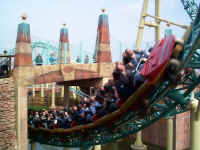 One
record that seems to have a certain durability to it, though, is the
record for the most inversions. Up until 1995, no park seemed to go
beyond a maximum of seven inversions. Opening with Port Aventura in
1995, the stalemate was eventually broken by Dragon Khan which tumbled
riders head-over-heels eight times. One
record that seems to have a certain durability to it, though, is the
record for the most inversions. Up until 1995, no park seemed to go
beyond a maximum of seven inversions. Opening with Port Aventura in
1995, the stalemate was eventually broken by Dragon Khan which tumbled
riders head-over-heels eight times.
As
the record for most inversions became stale, so too did Thorpe Park.
Whilst nearby Chessington was reeling from the effects the Vampire had
on their chances of getting permission for any more major rides, Thorpe
Park had the luxury of being able to build major rides but had to first
shed the reputation of being a glorified water park for kids to make
such investments pay for themselves.
The
‘Sensory Overload’ began in 2001 with the addition of three rides;
Detonator, Vortex and the somewhat less-thrilling Zodiac. But the park
needed a signature ride, and one with the impact to say that Thorpe were
now a big player. Breaking world records was the only way to go, and
with little over 100ft of airspace to play with it made sense that the
record they’d pursue would be for the most inversions.
So
far, the record still stood at eight inversions, with Dragon Khan now
sharing the honour with Brazilian roller coaster Monte Makaya. This
Intamin roller coaster was a small but perfectly formed 100ft tall, but
the inline twists in particular are particularly sparing when it comes
to the use of gravity, which enabled this relatively short ride to go
through a relatively high number of inversions.
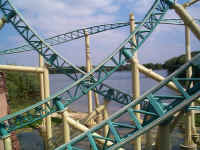 Replacing
the final helix, two additional inversions were added, both inline
twists which meant Thorpe Park would triumphantly steal the record for
most inversions by 2001 and therefore unearth a marketing goldmine. Replacing
the final helix, two additional inversions were added, both inline
twists which meant Thorpe Park would triumphantly steal the record for
most inversions by 2001 and therefore unearth a marketing goldmine.
Much
fanfare would accompany the construction of ‘Project Odyssey’ that
spanned the 2001 season as the park discovered more Lost City remains
from which the slender pale-cream supports would rise, topped by a
slender aqua-coloured track. In front of the construction site, a model
of the ride was displayed with every loop (by the laymen’s definition)
marked with a label detailing the inversion number, type and how many
inversions each element accounted for.
Come
2002, excited riders would have their very own chance to summersault
their way through a record-breaking ten inversions; a vertical loop,
cobra roll, a pair of corkscrews before ploughing through an
unprecedented four inline twists with only a brief respite before
rolling through a final inline twist onto the final brakes.
Lost
City is the largest area at Thorpe Park, both in geographical terms and
as far as ride counts are concerned. Considering it took even Tussauds
years to unearth Lost City, it alone is the single biggest example of
how Thorpe Park has grown since RMC sold the park.
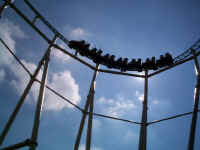 Whilst
many themes tell stories, Lost City’s theme elects to be merely
decorative. The style applied throughout the Lost City is simple
consisting mainly of crumbing stone buildings decorated with triangular
obelisks, which, when combined with the lush greenery and lakeside
setting brilliantly disguises the fact Colossus is essentially a clone
with knobs on. Whilst
many themes tell stories, Lost City’s theme elects to be merely
decorative. The style applied throughout the Lost City is simple
consisting mainly of crumbing stone buildings decorated with triangular
obelisks, which, when combined with the lush greenery and lakeside
setting brilliantly disguises the fact Colossus is essentially a clone
with knobs on.
The
queue line on busy days will take you onto a peninsula cast under the
shadows of the inline twists towards the end of the ride, before heading
straight into the centre of the ride, following the lift hill and then
splitting towards the station for those who want to do the first two
seats.
One
of two trains will be your conveyance throughout the ride, each seating
riders in a fairly standard 2x2 per car with seven cars per train. Each
dark red and gold car features elevated seating in the rear of each car
meaning that back seat riders get as much of a face full of the action
as those in the front.
The
loading of Colossus is neither fast nor efficient. For the computer to
register that the ride is ready for loading, every single restraint must
be pulled up into the full upright position by staff. Unlike Nemesis
Inferno, the ride offers no assistance by popping up off their own
accord, and are instead incredibly heavy and time consuming to open.
Not
until all the bars are up are the gates then opened for the throngs of
thrill seekers.
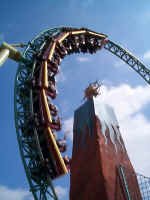 A
degree in osmosis will most certainly help riders of a normal stature
get into the rear of each car. Owing to a catalogue of issues including
lack of headroom thanks to the restraints design, lack of legroom due to
the seats in front, and a floor composed of numerous blocks to form
‘foot holes’, getting into the trains – specifically the back seat
– is a palaver at best. Once seated, though, the seat is comfortable
although the restraint is designed to keep wayward legs securely pinned
down which can be uncomfortable if you pull the restraint down to far. A
degree in osmosis will most certainly help riders of a normal stature
get into the rear of each car. Owing to a catalogue of issues including
lack of headroom thanks to the restraints design, lack of legroom due to
the seats in front, and a floor composed of numerous blocks to form
‘foot holes’, getting into the trains – specifically the back seat
– is a palaver at best. Once seated, though, the seat is comfortable
although the restraint is designed to keep wayward legs securely pinned
down which can be uncomfortable if you pull the restraint down to far.
Once
everyone is sat comfortably or otherwise, the train slowly advances out
of the station and immediately onto the 100ft lift hill. As the back of
the train starts the climb and the train behind enters the station, the
lift moves up a hear as you climb away from the ground affording
excellent views of Loggers Leap below, Nemesis Inferno stage right and
beyond the edge of the park to your left.
With
a clatter of anti-rollbacks, the train dips into a sweeping 180-degree
bend which slyly evolves into the first drop.
The
train makes an ungainly exit from the summit plummet, making a bid for
the sky but not without turning riders’ heads groundwards as the train
circles through a teardrop shaped vertical loop.
Falling
from orbit, the train buries itself underneath the main pathway through
Lost City arching over the queue-line below through a sublime bunnyhop.
As you head towards a shop window of waving children, almost as an
afterthought the train is pulled down an into a cavern beneath the
souvenir shop before sensationally erupting from the ground arcing up
into a snappy cobra roll – as the train plateaus above the walkway
below, it abruptly curls back into the opposite direction, plunging back
beneath the shop, climbing up through a sweeping curve which peels away
from the ground, tearing the train to the right hand side through a
clockwise corkscrew.
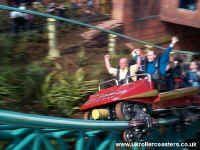 The
track takes on almost a needle and thread-like quality to it as it
threads itself up, over and through the fabric of Lost City. As the
corkscrew curls over the queueline below, the track threads itself
underneath the main pathway as it lurches into a second corkscrew,
itself rolling over the pathway below. The
track takes on almost a needle and thread-like quality to it as it
threads itself up, over and through the fabric of Lost City. As the
corkscrew curls over the queueline below, the track threads itself
underneath the main pathway as it lurches into a second corkscrew,
itself rolling over the pathway below.
Head
choppers abound as you pass through a forest of columns supporting the
first turnaround as you make a 180-degree turn regaining as much lost
height as possible before the ride changes from what has so-far been
pre-amble into a remorseless looping machine.
The
ride rolls its sleeves up by lining the train up with a perfectly
circular tunnel of inline twists, unveiling a quintet of inversions
enough to make even the most devout thrill seeker slack-jawed.
Like
staring into a washing machine on spin cycle, everything in your sight
soon becomes a kaleidoscope of colours as the train tumbles over, and
over... and over. And over.
The
restraint suddenly transforms itself from an obtrusive straightjacket to
a much appreciated lifejacket as your entire weight falls into the
restraint as you cartwheel through this horizontal steel vortex over
water, over the pathway, over the shrubbery below.
Nearly
quarter of a minute later, having travelled the entire length of the
ride somersaulting through inline twists, the train manages to break
free from this whirlpool and stumbles into a scenic turnaround, where
the track slowly climbs up and over the pathway right below.
With
execution like an afterthought, lest we forget the final inversion. Just
as you are able to start making out the detail on the back of the train
in the station, the train coils its way through a ground-hugging
anti-clockwise inline twist with the front of the train hitting the
brakes as the back is almost still upside-down.
Colossus
most certainly isn’t a passive experience, and takes you for a ride
from the outset. Whilst many criticise Colossus for being rough, you
have to ride with it to get the most out of it, and only then
does it show it’s true colours.
The
ride is at its most feisty at the base of the first drop which is the
only unexpected moment of roughness, and even so, this isn’t roughness
at the hands of Lucifer, just a sharp transition from a curved first
drop into a straight vertical loop.
Meanwhile,
the cobra roll is sharp and snappy, but is an element that is even
laterally forceful on B&M rides such as Superman Ride of Steel
(Movie World Madrid).
If
you do prefer your rides to be passive and less forceful, then a front
seat ride most certainly is worth the wait. Unlike the rest of the
train, the driving seat is as smooth as glass, yet still maintains this
unyielding sense of recklessness.
Colossus
gets off to a familiar and conventional start, but the inline twists
that abound the second chapter of this story really give Colossus an
identity of its own. Say what you will about multi-looping roller
coasters, but Colossus is quite unlike anything else in the world.
Whilst
many coasters fizzle out, Colossus literally explodes onto the brake run
by rolling through one last inversion, low enough for you to almost pick
daisies off the ground.
Even
beyond the subjective, Colossus is a success in every meaning of the
word. The ride succeeded in putting Thorpe Park on the map, and remains
the parks’ main workhorse in that respect. Furthermore, whilst many
immediately write off multi-looping coasters, to the public they remain
a unique phenomenon, especially Colossus which is quite unlike any
coaster in Europe.

MS
22 January 2004
|
Good points:
▪
Has set Thorpe Park up
well to be one of the best parks in South England
▪ Very unique to almost
everyone who rides it
▪ Powerful first half and unique second half
Bad points:
▪ Trains are poorly
designed
▪ Some people find the
ride uncomfortable
|
|